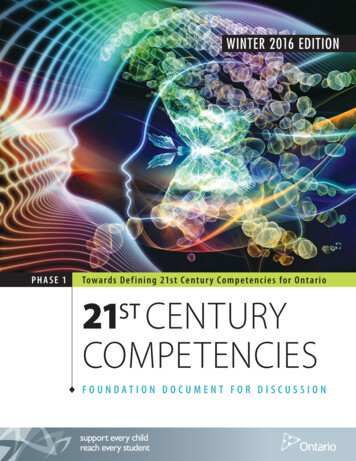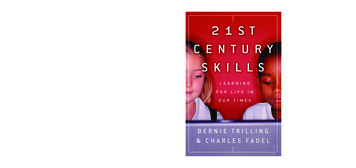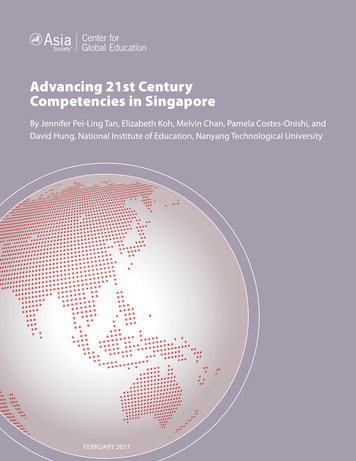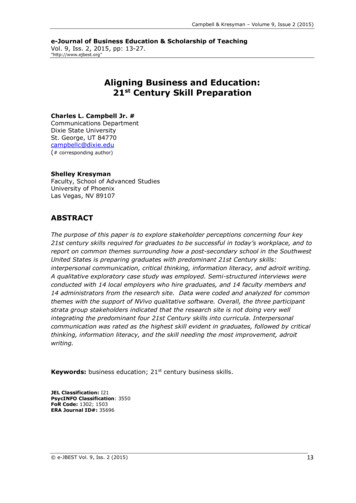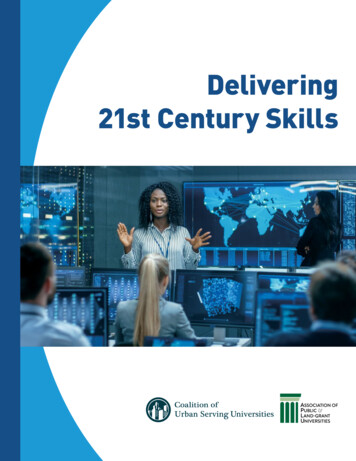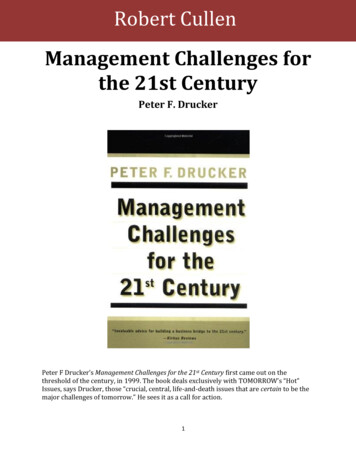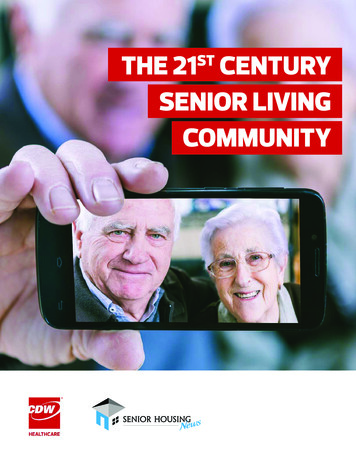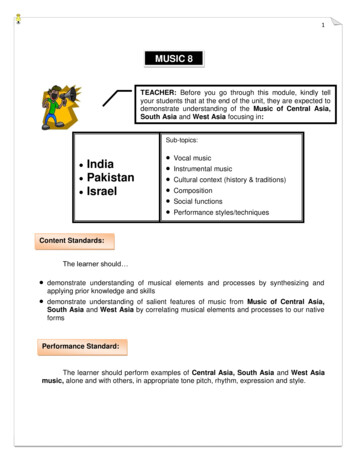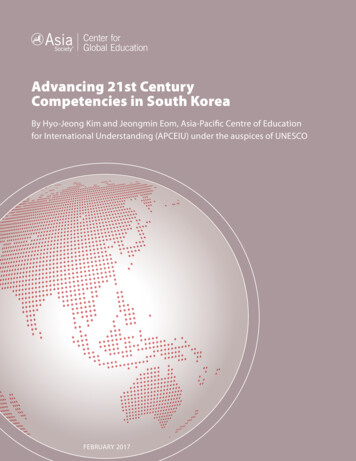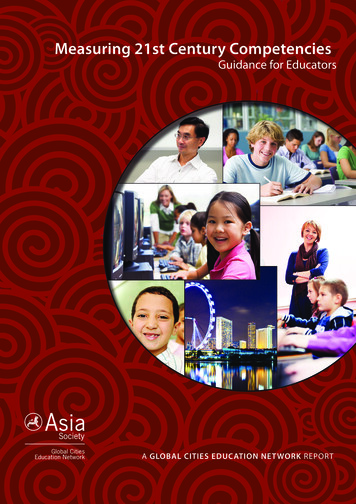
Transcription
Measuring 21st Century CompetenciesGuidance for EducatorsA GLOBAL CITIES EDUCATION NET WORK REPORTI
MEASURING21ST CENTURYCOMPETENCIESGUIDANCE FOR EDUCATORSRAND Corporation, November 2013Jim Soland, Laura S. Hamilton, and Brian M. StecherI
TABLE OF CONTENTSTablesFiguresAcknowledgmentsIIIIIIIV1. Introduction1The Global Cities Educational Network (GCEN)12. Examples of 21st Century Competencies3A Closer Look at Some 21st Century CompetenciesCognitive CompetenciesInterpersonal CompetenciesIntrapersonal CompetenciesConclusion445783. A Framework for Selecting Measures of 21st Century Competencies9PurposeInstructional ConsiderationsFormative versus SummativeUsefulness of the Data for Students and TeachersInfluence of Testing on Teaching and LearningPractical ConsiderationsCostLogistical RequirementsTechnical n9910101112121212131314154. Examples of 21st Century Assessments, by Format16Multiple ChoiceCommon Core State Standards Consortia AssessmentsSelf-Report (Likert)Closed-Ended Computer-Based ItemsOpen ResponsePortfoliosPerformance Assessments and SimulationsMeasuring Leadership: A Lesson in the Difficulties of Assessing 21st Century CompetenciesAdditional Sources of DataCross-Cutting Measures: A Deeper Look at the Mission Skills Assessment (MSA)The Intent of the Mission Skills AssessmentPractical ConsiderationsTechnical ConsiderationsInstructional Benefits and Challenges Associated with the MSAInstructional 37II
5. Guidelines for Measuring 21st Century Competencies38Considerations When Adopting or Adapting Assessments of 21st Century Competencies38Appendix. Case Studies of Cutting-Edge Measures43Alelo Language and Culture SimulationsCommon Core State Standards Consortia AssessmentsEcoMUVEThe Graduation Performance SystemMission Skills AssessmentPISA Collaborative Problem SolvingQueensland Performance AssessmentsSimScientistsSingapore Project WorkWorld Savvy le 1. Examples of 21st Century Competencies by CategoryTable 2. Considerations When Selecting Measures of 21st Century CompetenciesTable 3. Examples of Measures of 21st Century CompetenciesTable 4. PISA Draft Collaborative Problem-Solving FrameworkTable 5. Key Takeaways from an Investigation of Available Measures of 21st Century Competencies49173038FiguresFigure 1. Raven’s Progressive MatricesFigure 2. PARCC Prototype Item: Julia’s GardenFigure 3. Sample PARCC Spreadsheet ItemFigure 4. Sample ETS Formulating Hypotheses ItemFigure 5. Graduation Performance System (GPS) FrameworkFigure 6. Alelo Oral Language SimulationFigure 7. Alelo Oral Language Simulation Learning ObjectivesFigure 8. MSA Situational Judgment TestFigure 9. EcoMUVE Ecosystem Science LearningFigure 10. SimScientists Science Simulation19202426272930334652III
ACKNOWLEDGMENTSThe impetus for this paper came from Asia Society, whose Global Cities Education Network (GCEN)is helping international educators promote their students’ global competence. Tony Jackson and otherAsia Society staff helped us frame the paper, and representatives from the GCEN cities provideduseful information about their assessment efforts. The William and Flora Hewlett Foundation providedresources to support the writing of the paper and its dissemination by Asia Society to members of theGCEN and other stakeholders. The foundation also provided access to Merrilea Mayo, an assessmentexpert who helped with background research on assessment quality and validity for predicting collegeand career outcomes. We want to thank the educators we interviewed about their experiences withinnovative assessments, particularly Lisa Pullman at the Independent School Data Exchange (INDEX),who helped us arrange interviews with a number of teachers. We also benefited from the insights ofmany test developers, including those responsible for designing many of the assessments highlighted inthis report. Two anonymous reviewers offered valuable suggestions on an earlier draft. Finally, we aregrateful to James Torr for assistance with editing and Donna White for help with document preparation.IV
INTRODUCTIONPublic school systems are expected to promote a wide variety of skills and accomplishments in theirstudents, including both academic achievement and the development of broader competencies, suchas creativity, adaptability, and global awareness. The latter outcomes, which are often referred to as“21st century skills” or “21st century competencies,” have recently taken a more central role in policydiscussions, because they are seen as critical components of college and career readiness. For example,in the United States, more than forty states have adopted the Common Core State Standards (CCSS),which are designed to embody a broader view of the knowledge and skills needed for success in collegeand careers. This growing emphasis on outcomes beyond simple academic content knowledge is theresult of a confluence of factors, including perceptions among some business and government leadersthat globalization, technology, migration, international competition, and changing markets require agreater emphasis on these outcomes than was required in the past. As a result, school systems arefacing increasing pressure to produce graduates with this range of competencies (i.e., knowledge, skills,attitudes, and dispositions), a demand that generates challenges in terms of pedagogy and assessment.In a previous Asia Society report, Saavedra and Opfer (2012) summarized lessons from research onlearning to identify promising strategies for teaching 21st century competencies. For example, theystressed the importance of making curriculum relevant, helping students learn how to teach themselves,and fostering creativity. This report builds on that foundation by examining how to assess 21st centurycompetencies.1 Fortunately, data systems and measurement techniques that provide opportunities toassess students’ attainment of these outcomes are increasingly available. This report is intended toacquaint teachers, school leaders, and district administrators with the current state of 21st centurycompetencies assessment, provide examples of relevant measures that educators in the field may wishto consider using, and offer some guidance to help educators compare measures and implement anassessment system.Given these objectives, the report proceeds as follows. In Chapter 2, we describe a number of important21st century competencies that will serve as our focus for the remainder of the report. Chapter 3 presentsa set of criteria that educators should consider when deciding whether, when, and how to measure thesecompetencies. These criteria guide the selection of assessment examples of 21st century competenciespresented in Chapter 4. The inclusion of an assessment in this chapter is neither an endorsement of thatassessment nor a confirmation that it achieves particular measurement goals; rather, we try to provideexamples that are representative of the tests in the field, so that practitioners can make more informedassessment decisions. Finally, Chapter 5 draws on the previous information to offer a set of guidelinesto help potential users of assessments make more informed choices.The Global Cities Educational Network (GCEN)This report was prepared as a resource for schools and school systems, and the GCEN in particular.Globalization of the economy, increasingly diverse and interconnected populations, and rapidtechnological change are posing new and demanding challenges to individuals and societies alike. Schoolsystems are rethinking what knowledge and skills students will need for success and the educationalstrategies and systems required for all children to achieve them. In both Asia and North America, urbanschool systems are at the locus of change in policy and practice—at once the sites of the most criticalchallenges in education and the engines of innovation needed to address them.Throughout the report, we use the terms “assessment,” “examination,” “test,” and “measure” fairly interchangeably. Forexample, when we discuss assessments, we are also including the examinations on which education systems in much of Asiaand Europe rely.11
Asia Society organized the GCEN, a network of urban school systems in North America and Asia,to focus on challenges and opportunities for improvement common to them and to virtually all cityeducation systems. A critical element of high-performing school systems is that they not only benchmarktheir practices against those of other countries, but they also systematically adapt and implement bestpractices within their own cultural and political contexts. The GCEN is intended as a mechanism foreducators and decision makers in Asia and North America to collaboratively dream, design, and deliverinternationally informed solutions to common challenges with which education systems are currentlygrappling.2
2. EXAMPLES OF 21ST CENTURY COMPETENCIESThe term “21st century competencies” means different things to different people, and descriptions ofthese competencies rarely match one another exactly. Our purpose is not to provide a comprehensivecatalog of 21st century competencies but to explore the challenge of assessing such outcomes, whichare not widely measured and are not always amenable to the traditional assessment formats used foracademic achievement tests. For this purpose, it is important that we identify a diverse set of 21st centurycompetencies, not that we identify all such outcomes. It is also important that we select competenciesthat illustrate a broad range of assessment approaches.To ensure that our analyses reflect the full range of competencies, we begin by describing broad categoriesof outcomes deemed to be vital in the 21st century, and then we identify a diverse set of exemplars withineach category. This approach helps ensure wide coverage and reasonable balance among the differingskillsets subsumed under the general heading of 21st century competencies. This two-level structuremirrors the approach taken by a number of organizations in the United States, Asia, and internationally.At the top level, we loosely follow the categories used by the National Research Council, which alsoreflect the priorities articulated by GCEN members and various organizations with expertise in 21stcentury competencies. These broad categories are the following: Cognitive competencies Interpersonal competencies Intrapersonal competenciesThere are a number of specific competencies within each category that educators and policy makersdeem essential to success in the global economy. We selected a small number of these competencies asour focus (see Table 1). Our selection was based primarily on two factors: (a) there is research suggestingthat educators can influence student mastery of these competencies, and (b) the competencies aredefined well enough to permit a range of assessment options.The cognitive category includes mastery of core academic content, including but not limited tomathematics, science, language arts, foreign languages, history, and geography. Cognitive competenciesalso include critical thinking and creativity, both of which were identified by GCEN members and globalorganizations as fundamental in a transnational economy. While these various competencies all relateto cognition, the name of this category does not imply that other competencies do not. In fact, all ofthe competencies in this report involve higher-level thinking of some kind.The interpersonal categorycovers the competencies that students need in order to relate to other people. These competenciesbegin with the basic capacity to communicate. Communication, in turn, sets the foundation for moremultifaceted outcomes, such as collaboration and leadership. Given the GCEN’s focus on globalcompetence, we also include global awareness among the interpersonal competencies; global awarenessrefers to a demonstrated empathy for the diverse circumstances that people experience across countriesand an understanding of the interrelatedness of people, institutions, and systems. Beyond its altruisticvalue, global awareness has been shown to predict a heightened ability to navigate the complexities ofinternational markets.The intrapersonal category includes the competencies “that reside within the individual and aid him orher in problem solving” (Koenig 2011, 21). This category can also be conceptualized as the attitudes andbehaviors that influence how students apply themselves in school, work, and other settings. Such attitudes3
TABLE 1Examples of 21st Century Competencies by CategoryCognitive CompetenciesAcademic masteryCritical thinkingCreativityInterpersonal CompetenciesCommunication and collaborationLeadershipGlobal awarenessIntrapersonal CompetenciesGrowth mindsetLearning how to learnIntrinsic motivationGritinclude having a growth mindset, learning how to learn, being motivated to succeed, and showing grit inpursuing goals. Recently, the intrapersonal category has received considerable attention from educatorsand employers. This attention results from emerging research showing that intrapersonal competenciescan, in some contexts, predict long-term academic and economic outcomes (Duckworth, Peterson, andMatthews 2007; Dweck 2008; Walton and Cohen 2011). These studies also find that educators cangenerate specific, cost-effective interventions to improve these competencies for students, especiallythose at risk of low achievement and attainment (Dweck 2008; Walton and Cohen 2011; Yeager andWalton 2011; Yeager, Walton, and Cohen 2013), though uncertainty remains about whether these studiesgeneralize to a broad range of student populations.A CLOSER LOOK AT SOME 21ST CENTURY COMPETENCIESThis section provides greater detail on the specific competencies we sampled in each of the three broadcategories. It is important to have a precise definition for a given competency when trying to measureit, so we present commonly used definitions of the competencies we’ve chosen to examine. We alsoprovide some evidence about the importance of these competencies for students in the 21st century.Readers might find that some competencies are more relevant to their contexts than others, and they canfocus on those throughout the document.Cognitive CompetenciesAmong the many cognitive competencies, we highlight three in this paper: academic mastery, criticalthinking, and creativity. These three are grouped together because they incorporate either knowledge incore academic subjects or the skills that relate to how one processes this knowledge. While intrapersonalcompetencies also influence how one thinks about academic content, they are more attitudinal in naturethan the competencies that relate directly to mastery of core content and are therefore treated separately.Academic MasteryLearning academic content is fundamental to education, and mastery of such content serves as thebasis for higher-order thinking skills as well as the impetus for improved interpersonal and intrapersonalcompetencies. Academic content includes instruction in subjects such as mathematics, science, reading,global studies, and foreign languages. We include global studies on this list because of its importance4
to GCEN members and because the World Bank (among others) has found it to be important foreconomic growth in general, and for building effective partnerships between Asia and the United States inparticular (Almeida 2009). Understanding regional norms and being able to communicate across cultureshas gained increased prominence in recent years as a result of the increasingly global economy. Academicmastery is also important, because efforts to improve interpersonal and intrapersonal competencies likecommunication, academic mindset, and learning to learn are best accomplished within the context ofacademic instruction in a specific subject (Boix-Mansilla and Jackson 2011; Gardner and Boix-Mansilla1994; Grotzer and Basca 2003; Mansilla and Gardner 1998; Saavedra and Opfer 2012). Although 21stcentury competencies such as communication appear to be important to a variety of later educationaland career outcomes in their own right, they do not operate independent of academic outcomes.Critical ThinkingCritical thinking is highlighted in almost every discussion of key competencies for the 21st century.According to Facione and colleagues (1995), critical thinking includes inductive and deductive reasoning,as well as making correct analyses, inferences, and evaluations. These competencies are important fordeeply understanding academic content, and they also relate to later career performance. Researchsuggests that for a company to compete in the global economy, it needs workers who will think abouthow to continuously improve its products, processes, or services. According to many executives, theheart of this continuous improvement process is knowing the right questions to ask (Wagner 2010),a function of critical thinking. Studies also tie critical thinking to other important societal outcomes.For example, Facione (1998) argues that citizens who think critically are likelier to be self-sufficientand therefore less of a drain on state resources. Meanwhile others suggest that such citizens are betterequipped to give back to society, including through social entrepreneurship aimed at benefiting others(Peredo and McLean 2006).CreativityMany educators and employers see creativity as a vital 21st century competency. While researchers havenot settled on a single definition of creativity, Jackson and Messick (1965, 319) suggest that “unusualness,appropriateness, and transformation in varying combinations characterize a large proportion of thosethings we are willing to call creative.” Though creativity has been defined variously since Jackson andMessick, many prominent definitions do not stray too far from these authors’ conceptualization (El-Muradand West 2004; Parkhurst 1999; Runco 1996). Given its broad applicability and value to entrepreneurship,creativity is included among the key 21st century competencies by a range of organizations and scholars,including the Organisation for Economic Co-operation and Development (2013), the National ResearchCouncil (Pellegrino and Hilton 2013), the Hewlett Foundation (Conley 2011), ETS (Kyllonen 2008), andthe World Bank (Di Gropello 2011). Innovation in particular has consistently been identified as a drivingforce in 21st century economic development (Archibugi and Lundvall 2002; Sawyer 2006; Wagner 2010).Partially as a result, creativity has gained increasing focus in educational programs globally. For example,China and Singapore have devoted resources to fostering more creativity in their schools. It is importantto note that definitions of creativity can be culturally specific (Trompenaars and Hampden-Turner 1998).Though it is beyond the scope of this report to address nuances in how different cultures conceptualizecreativity, schools and school systems should be alert to cultural specificities when defining creativity (aswell as many other constructs considered in this report).Interpersonal CompetenciesWe highlight three interpersonal competencies: communication and collaboration, leadership, and globalawareness. We combine communication and collaboration because the latter relies heavily on the former,and it is difficult to measure collaboration independent of communication. In fact, there is overlap amongmany of these competencies, because they are founded on interpersonal interaction; e.g., leadershipinvolves both communication and collaboration. Many formulations of 21st century competencies include5
tolerance and sensitivity; we subsume these characteristics under the heading of global awareness, whichinvolves empathy for people in diverse circumstances, among other competencies.Communication and CollaborationWe consider communication and collaboration jointly for practical reasons, although each is itself a broadconcept. For example, communication is sometimes broken down into three qualities: clarity, informationshared, and balance among participants (Mohr, Fisher, and Nevin 1996). Similarly, collaboration canbe thought of as communication plus additional competencies related to conflict resolution, decisionmaking, problem solving, and negotiation (Lai 2011).Communication and collaboration are identified as vital 21st century competencies by almost all of theorganizations we consulted, by the GCEN members with whom we spoke, and by most researchers. Forexample, Pellegrino and Hilton (2013) suggest that communication is vital to facilitate teamwork and liesat the core of empathy, trust, conflict resolution, and negotiation. For instance, effectiveness with clientsoften hinges on effective communication and the teamwork necessary to produce a superior product.The importance of communication and collaboration in the workforce has generated increased focuson these skills in schools. As an example, the Houston Independent School District (a GCEN member)requires students to give group presentations in front of local executives to improve the students’ abilityto communicate and collaborate.LeadershipLeadership can be difficult to define because it includes aspects of communication and collaboration,along with a sense of vision for the future and competencies involving working with people. Morebroadly, leadership is not just a competency but a set of competencies. For example, a study conductedacross Asian countries suggested that leadership involves having initiative, building consensus, innovatingnew strategies, and implementing policies and programs in collaboration with or under the direction ofothers (Berman et al. 2013). Moreover, because leadership involves working with and managing otherpeople, including their competing priorities, collaboration is an important competency for a leader topossess. Research also suggests that the nature of leadership may be changing. Statistics show that anincreasing number of college graduates will find employment in an organization they started themselves(Ball, Pollard, and Stanley 2010; Di Addario and Vuri 2010; Nabi, Holden, and Walmsley 2010; Tanveeret al. 2013). As start-up businesses play a larger role in the economy, it will be critically important forleaders of these businesses to have the ability to not only act on a vision but also to nimbly organizeothers around that vision ( Ball, Pollard, and Stanley 2010).Global AwarenessGlobal awareness has grown in importance in the 21st century as economic, social, and culturalconnections among countries have increased. Though global awareness involves a major academic,cognitive component, we include it in the interpersonal competencies section because it also requires abevy of complex interpersonal skills. Perhaps the best-studied interpersonal competency that underliesglobal awareness is empathy. For instance, a student might demonstrate global awareness if he or she feelsempathy for people in different cultural or geopolitical circumstances (Bachen, Hernández-Ramos, andRaphael 2012). However, this specific form of empathy is only one facet of the interpersonal nature ofglobal awareness. To be globally aware, a person must also show an understanding of the interrelatednessof people, institutions, and systems. Being able to connect how actions in one area of the world affectother areas, or how local events influence and are influenced by global events, is a core part of globalawareness. These interpersonal aspects of global awareness have been tied to success in the internationaleconomy. For example, Boix-Mansilla and Jackson (2011) suggest that students must know how toinvestigate the world, weigh perspectives, communicate ideas, take action, and apply expertise in order toprosper in a global, multicultural workforce.6
Intrapersonal CompetenciesIntrapersonal competencies can be conceptualized as the attitudes and behaviors that influence howstudents apply themselves in school, work, and a range of other settings. For example, being motivatedleads to better performance in a number of contexts and on a variety of tasks. Increasingly, educatorsbelieve that improving intrapersonal competencies is key to maximizing student potential. Researchshows, for instance, that at-risk students achieve at higher levels when they possess a growth mindset(Dweck 2006; Walton and Cohen 2011; Yeager, Walton, and Cohen 2013). We sample four competenciesfrom this category: growth mindset, learning how to learn, intrinsic motivation, and grit.Growth MindsetStudents with a growth mindset see intelligence as malleable and as a function of effort, whereas thosewith a fixed mindset treat intelligence as an innate ability, immune to the efforts of the individual toimprove it (Dweck 2006; Dweck 2008; Dweck 2009; Dweck 2010). Over more than a decade, CarolDweck has chronicled the advantages of having a growth mindset rather than a fixed mindset whenit comes to learning core academic content in subjects such as mathematics and science. For example,she shows that students often perform better in mathematics when they possess a growth mindset,because they are more willing to engage with difficult material and overcome setbacks (Dweck 2008).More recently, Dweck and others have applied her mindset framework to 21st century competenciesframeworks, suggesting that students are in a much better position to develop 21st century competenciesif they exhibit the right mindset (Dweck 2009; Stevenson et al. 1990; Stevenson, Lee, and Stigler 1986;Stigler and Stevenson 1991).Learning How to LearnLearning how to learn, or “metacognition,” refers to a student’s ability to determine how to approacha problem or task, monitor his or her own comprehension, and evaluate progress toward completion(Landine and Stewart 1998; Vrugt and Oort 2008). Much research documents the importance ofmetacognition to academic achievement (Landine and Stewart 1998; Paris and Winograd 1990; Schunkand Zimmerman 2012; Vrugt and Oort 2008; Zimmerman 1990; Zimmerman 2001). David Conley inparticular ties metacognition directly to college readiness and uses the term to encompass many of theother competencies discussed in this report (Conley 2008). We interpret learning how to learn broadlyto include related competencies, such as self-regulation, which has been shown to predict achievement,attainment, and workforce success. For example, Vrugt and Oort (2008) show that self-regulated learnershave significantly better achievement test scores than their peers. Research shows that metacognitivecompetencies also influence how students respond to classroom instruction. A student who understandshis or her own learning processes is better able to self-motivate, respond to teacher feedback, and developstronger self-perceptions of academic accomplishment (Zimmerman 1990).Intrinsic MotivationMotivation refers to the process that prompts people to take action to attain particular goals, andpsychologists generally distinguish between two types of motivation. Extrinsic motivation refers topressures to act that derive from sources outside the individual; these include incentives such as moneyor, in the case of students, praise or grades. Intrinsic motivation refers to forces within the individual thatactivate behavior. Students might demonstrate intrinsic motivation if they spent extra time learning abouta topic in science because they are interested in it, whether or not it was a required assignment. Researchshows that without motivation of some type, students are unlikely to master core academic content(Barca-Lozano et al. 2012; Deci et al. 1991; Goslin 2003; Guay et al. 2010). In fact, there is evidence(including research in schools in Asia) that both types of motivation matter to educational achievement.Since extrinsic motivation is largely a feature of setting, we focus our examination on assessing intrinsicmotivation, which is an attribute of the learner. Interestingly, intrinsic motivation has been shown to be7
an important element in complex problem solving and achievement (Deci and Ryan, 2012; Deci et al.,1991; Ryan and Deci, 2000a, 2000b; Stone, Deci, and Ryan, 2009).2 Although in many cases extrinsicincentives can result in students working harder than they would in the absence of those incentives,there is some evidence that for certain (though not all) complex tasks, the use of extrinsic incentives canreduce performance and long-term interest in the task (Deci et al. 1991; Ryan and Deci 2000a). Intrinsicmotivation has been found to be especially important in higher education, where enrollment is more atthe discretion of the student (Lin, McKeachie, and Kim 2001; Ryan and Deci 2000b).GritGrit is an emerging construct that relates directly to intrinsic motivation and has been shown to predictimportant outcomes, including achievement (Duckworth et al. 2007; Duckworth and Quinn 2009).Whereas motivation refers to an immediate interest or desire to engage in an activity, grit refers toperseverance and passion for long-term goals (Duckworth et al. 2007). Thus a person could be motivatedbut still lack grit if he or she focused attentively on everyday work but lost interest in a project over timeand failed to complete it. Research shows that students reach higher levels of educational attainmentwhen they demonstrate grit (Duckworth et al. 2007). Moreover, teachers that evince more grit tend tostay in the profession longer and generate larger test-score gains for their students in mathematics andlanguage arts (Duckworth, Quinn, and Seligman 2009). Although there is a positive correlation betweenmeasures of grit and later outcomes of interest, there are still unanswered questions about the role ofgrit in student success and how grit relates to other constructs. For example, there seems to be overlapamong discussions of motivation, grit, and resilien
2. EXAMPLES OF 21ST CENTURY COMPETENCIES The term "21st century competencies" means different things to different people, and descriptions of these competencies rarely match one another exactly. Our purpose is not to provide a comprehensive catalog of 21st century competencies but to explore the challenge of assessing such outcomes, which
